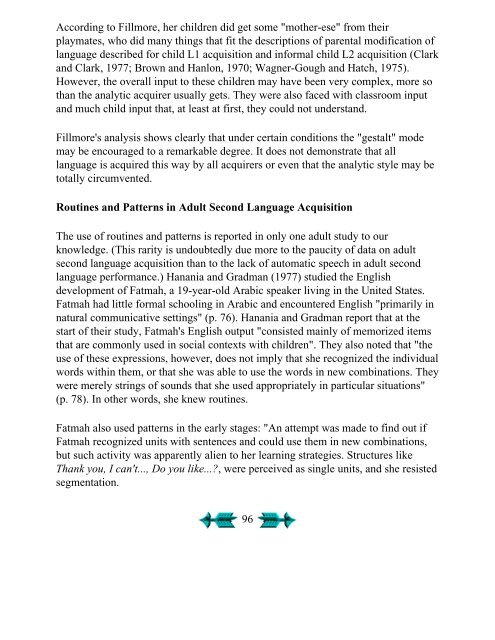Second Language Acquisition and Second ... - Stephen Krashen
Second Language Acquisition and Second ... - Stephen Krashen
Second Language Acquisition and Second ... - Stephen Krashen
You also want an ePaper? Increase the reach of your titles
YUMPU automatically turns print PDFs into web optimized ePapers that Google loves.
According to Fillmore, her children did get some "mother-ese" from their<br />
playmates, who did many things that fit the descriptions of parental modification of<br />
language described for child L1 acquisition <strong>and</strong> informal child L2 acquisition (Clark<br />
<strong>and</strong> Clark, 1977; Brown <strong>and</strong> Hanlon, 1970; Wagner-Gough <strong>and</strong> Hatch, 1975).<br />
However, the overall input to these children may have been very complex, more so<br />
than the analytic acquirer usually gets. They were also faced with classroom input<br />
<strong>and</strong> much child input that, at least at first, they could not underst<strong>and</strong>.<br />
Fillmore's analysis shows clearly that under certain conditions the "gestalt" mode<br />
may be encouraged to a remarkable degree. It does not demonstrate that all<br />
language is acquired this way by all acquirers or even that the analytic style may be<br />
totally circumvented.<br />
Routines <strong>and</strong> Patterns in Adult <strong>Second</strong> <strong>Language</strong> <strong>Acquisition</strong><br />
The use of routines <strong>and</strong> patterns is reported in only one adult study to our<br />
knowledge. (This rarity is undoubtedly due more to the paucity of data on adult<br />
second language acquisition than to the lack of automatic speech in adult second<br />
language performance.) Hanania <strong>and</strong> Gradman (1977) studied the English<br />
development of Fatmah, a 19-year-old Arabic speaker living in the United States.<br />
Fatmah had little formal schooling in Arabic <strong>and</strong> encountered English "primarily in<br />
natural communicative settings" (p. 76). Hanania <strong>and</strong> Gradman report that at the<br />
start of their study, Fatmah's English output "consisted mainly of memorized items<br />
that are commonly used in social contexts with children". They also noted that "the<br />
use of these expressions, however, does not imply that she recognized the individual<br />
words within them, or that she was able to use the words in new combinations. They<br />
were merely strings of sounds that she used appropriately in particular situations"<br />
(p. 78). In other words, she knew routines.<br />
Fatmah also used patterns in the early stages: "An attempt was made to find out if<br />
Fatmah recognized units with sentences <strong>and</strong> could use them in new combinations,<br />
but such activity was apparently alien to her learning strategies. Structures like<br />
Thank you, I can't..., Do you like...?, were perceived as single units, <strong>and</strong> she resisted<br />
segmentation.<br />
96











